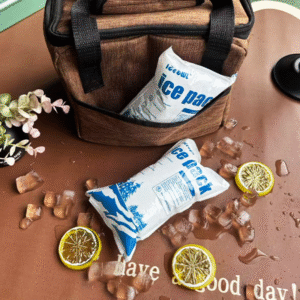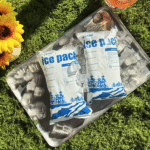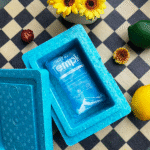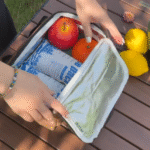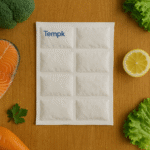Wenn Sie eine Feldklinik vorbereiten, B. den Transport von Biologika durch die Wildnis oder die Planung einer langen Wanderung, Trockeneisblöcke in medizinischer Qualität für den Außenbereich sind deine Geheimwaffe. Diese Blöcke werden aus hochreinem Kohlendioxid hergestellt, eingefroren bei –78,5 °C, und sie sublimieren direkt zu Gas, hinterlässt kein Wasser. Ihre extreme Kälte hält Impfstoffe zurück, Laborproben und Tiefkühlgerichte sind tagelang haltbar und eliminieren das unordentliche Schmelzen, das mit gewöhnlichem Eis einhergeht. Dabei 2025 In der Anleitung erfahren Sie, wie Sie auswählen, Größe und Handhabung dieser Blöcke, Befolgen Sie Vorschriften und nutzen Sie neue Trends. Am Ende, Sie wissen, wie Sie Ihre Ladung beim Wandern schützen, Camping oder die Durchführung einer mobilen Gesundheitsmission.
Was einen Trockeneisblock in medizinischer Qualität ausmacht und warum er sich im Freien auszeichnet: Reinheit verstehen, Sublimation und Formfaktoren
So dimensionieren und verpacken Sie Blöcke richtig: Berechnen Sie Wartezeiten und schichten Sie sie für Wanderausflüge oder abgelegene Kliniken ein
Sicherheits- und behördliche Anforderungen: Master-UN1845-Etiketten, Gewichtsgrenzen und Belüftungsregeln für den Transport
Vergleich mit anderen Kühlmitteln: Sehen Sie, wann Sie Trockeneis verwenden sollten, Gelpackungen oder Phasenwechselmaterialien
Letzte 2025 Trends: Entdecken Sie nachhaltige Isolierung, IoT-Überwachung, Hybridkühlung und Marktwachstum
Praktische Tipps, Fallstudien und FAQs: Wenden Sie Lehren aus echten Outdoor-Expeditionen an und erhalten Sie Antworten auf häufig gestellte Fragen
Was sind Trockeneisblöcke in medizinischer Qualität und warum werden sie im Freien verwendet??
Direkte Antwort
Trockeneisblöcke in medizinischer Qualität bestehen aus hochreinem Kohlendioxid, das zu dichten Platten gefroren ist und bei –78,5 °C sublimiert, langlebig liefern, Feuchtigkeitsfreie Kühlung, ideal für Feldkliniken, Expeditionsnahrung und sensible Biologika. Sie unterscheiden sich von Verbraucher-Trockeneis dadurch, dass sie nach strengen Standards hergestellt werden, um Verunreinigungen zu vermeiden, und oft in Blockgrößen geschnitten werden, die eine stabile Konsistenz gewährleisten, kontrollierte Kälteabgabe. In Outdoor-Szenarien, Diese Blöcke halten die extrem kalten Temperaturen mehrere Tage lang aufrecht und hinterlassen kein Schmelzwasser, Damit eignen sie sich perfekt zum Schutz von Impfstoffen oder Tiefkühlgerichten.
Erklärung und Hintergrund
Aus Ihrer Sicht, Ein medizinischer Block ist wie ein tragbarer Gefrierschrank, der keinen Strom benötigt. Weil es festes Kohlendioxid ist, Es senkt die Umgebungstemperatur schnell und hält sie weit unter dem Gefrierpunkt. Im Gegensatz zu Gel oder Wassereis, Es SULBLIMATE– direkte Umwandlung von Feststoff in Gas – so bleibt Ihr Kühler trocken und Ihre Produkte bleiben nicht in einer Pfütze liegen. Blöcke sind größer und schwerer als Pellets, was ihnen ein geringeres Verhältnis von Oberfläche zu Masse verleiht. Das bedeutet, dass sie ihre Erkältung langsamer abgeben und länger anhalten, Dies ist bei mehrtägigen Wanderungen oder beim Transport von Impfstoffen in abgelegene Dörfer von entscheidender Bedeutung. Für kürzere Ausflüge, Nuggets oder Pellets sorgen für einen schnellen Abbau, lösen sich aber schneller auf.
Trockeneis in medizinischer Qualität ist als Lebensmittel- und Pharmazusatzstoff reguliert. Es muss den Reinheitsanforderungen genügen, Typischerweise 99.9 % Co₂, und stammen von Lieferanten, die gute Herstellungspraktiken befolgen. Diese hohe Reinheit verhindert Geschmacksstörungen oder Verunreinigungen, wenn der Block in der Nähe von Medikamenten oder Lebensmitteln verwendet wird. In der Kaltkette Industrie, Diese Blöcke werden häufig mit isolierten Boxen kombiniert, um für mRNA-Impfstoffe und Zelltherapien eine Temperatur von –50 °C oder weniger aufrechtzuerhalten. Draußen, Sie sichern gefrorenen Fisch und Fleisch für Jäger und Abenteurer. Denn das Gas ist schwerer als Luft, Sie sollten Kühler belüften und niemals einen Block in einem luftdichten Behälter verschließen, um einen Druckaufbau zu vermeiden.
Wie lange halten Trockeneisblöcke in medizinischer Qualität im Freien??
Lang anhaltende Leistung ist der Hauptvorteil eines Blocks. Ein einzelner Block kann für eine gleichmäßige Kühlung sorgen zwei bis drei Tage in einem isolierten Kühler. Die genaue Dauer hängt von der Blockgröße ab, Isolationsqualität und Umgebungstemperatur. Zum Beispiel, A 5 Ein kg-Block in einem dickwandigen Kühler könnte Impfstoffe für einen Zeitraum unter –20 °C halten 48 Std.; ein größerer 10 kg-Block könnte das Fenster erweitern 72 Std.. Im Gegensatz, Pellets halten möglicherweise nur 12–24 Stunden, da ihre geringe Größe die Sublimation beschleunigt. Flexible Trockeneisplatten, die mehrere Zellen enthalten, Kann passend zugeschnitten werden und bietet je nach Zellzahl und Isolierung 24–72 Stunden Kühlung.
| Trockeneisform | Typische Dauer | Eignung | Praktischer Nutzen |
| Block (medizinische Qualität) | 48–72 Stunden in einer isolierten Kühlbox | Lange Expeditionen, Feldkliniken | Eine geringe Oberfläche verlangsamt die Sublimation; Hält eine konstante ultrakalte Temperatur aufrecht |
| Nugget/Pellet | 12–24 Stunden | Tageswanderungen, schnelle Abklingzeiten | Kühlt den Inhalt schnell ab, löst sich aber schneller auf |
| Blatt (5–20 Zellen) | 24–72 Stunden | Camping oder Schifffahrt mit begrenztem Platzangebot | Flexibel und schneidbar; Passt auf unregelmäßige Behälter und reduziert das Gewicht |
Praktische Tipps und Ratschläge
Wählen Sie Blöcke für mehrtägige Ausflüge: Blöcke eignen sich am besten, wenn Sie eine zuverlässige Kühlung benötigen 48 Stunden oder länger. Pellets mögen für eintägige Veranstaltungen ausreichen, sind aber nicht so lange haltbar.
Kühlen Sie Ihren Kühler vor: Kühlen Sie den Behälter mehrere Stunden lang mit normalem Eis, um die anfängliche Wärmebelastung zu reduzieren.
Separate Artikel: Legen Sie eine Schicht Pappe oder ein Handtuch zwischen den Block und Ihr Essen; kalte Luftwaschbecken, Wenn Sie also Gegenstände über dem Block stapeln, bleibt alles gleichmäßig gefroren.
Den Deckel entlüften: Öffnen Sie den Kühlerdeckel oder verwenden Sie belüftete Konstruktionen, um das CO₂-Gas entweichen zu lassen, Druckaufbau verhindern.
Verwenden Sie Handschuhe und Schutzbrille: Fassen Sie Blöcke immer mit isolierten Handschuhen und Augenschutz an, um Erfrierungen zu vermeiden.
Echtes Beispiel: Eine Wandergruppe nutzte a 10 Ein Pfund-Block, eingewickelt in ein Handtuch, plus normales Eis. Sie kühlten den Kühler vor und trennten die Getränke. Der Block hielt Fleisch und Fisch drei Tage lang gefroren, während die Salate knackig blieben und sich kein Wasser am Boden sammelte.
So dimensionieren und verpacken Sie Trockeneisblöcke in medizinischer Qualität für Ausflüge im Freien?
Direkte Antwort
Bemessen Sie Ihren Trockeneisblock in medizinischer Qualität, indem Sie das Gewicht an die Reiselänge und die Nutzlast anpassen, normalerweise mit 5–10 Pfund (2.3–4,5 kg) pro 24 Stunden Transport und Anpassung an Isolationsqualität und Umgebungstemperatur. Beginnen Sie mit einer Grundlinie, die dem Gewicht Ihrer gefrorenen Ladung entspricht; Für heißes Wetter oder wiederholte kühlere Öffnungen extra hinzufügen. Richtiges Packen – mit Schichten, Trennung und minimaler Kopfraum – verlängert die Haltezeit.
Erklärung und Hintergrund
Die Berechnung der Menge an Trockeneis, die Sie benötigen, kann kompliziert erscheinen, aber eine einfache Faustregel funktioniert: 5–10 Pfund pro Tag. Verwenden Sie das untere Ende, wenn Sie über eine hochwertige Isolierung und kühles Wetter verfügen; Verwenden Sie das höhere Ende für Sommerausflüge oder dünne Kühlboxen. Zum Beispiel, wenn Sie tragen 6 kg gefrorener Impfstoffe auf einer dreitägigen Mission, multiplizieren 6 kg um drei Tage und planen Sie ungefähr ein 18 kg Trockeneis. Denn Blöcke halten länger als Pellets, Sie können das Gewicht leicht reduzieren, aber immer einen Puffer für Verzögerungen einplanen.
Die Verpackung ist genauso wichtig wie die Größe. Die empfohlene Fünf-Schichten-Methode Wird in professionellen Kühlketten verwendet und kann für den Außenbereich angepasst werden:
Vorkühlen: Legen Sie eine kleine Menge Trockeneispellets oder gefrorene Wasserflaschen für 15–30 Minuten in die leere Kühlbox, um die anfängliche Wärme aufzunehmen.
Untere Schicht: Legen Sie den medizinischen Block flach in eine versiegelte Einlage oder Flachverpackung. Dadurch entsteht ein kalter Boden und die Wärmeleitung wird reduziert.
Seitenwände: Fügen Sie an den Seiten halbgroße Blöcke oder reflektierende Folien ein, um die seitliche Wärmeübertragung zu verhindern.
Produkt: Legen Sie Ihre Impfstoffe oder Lebensmittel in isolierte Schalen oder Sekundärbeutel, um direkten Kontakt und Frostschäden zu vermeiden.
Oberschicht: Legen Sie eine weitere Trockeneisplatte oder einen kleineren Block darauf, um die Strahlungswärme vom Deckel zu blockieren.
Diese Anordnung sorgt dafür, dass kalte Luft nach unten und über Ihre Ladung strömt, während das Gas nach oben entweicht. Für Rucksacktouren, Wenn das Gewicht von entscheidender Bedeutung ist, können Sie die Konstruktion auf einen unteren Block und eine dünne obere Platte vereinfachen. Schneiden Sie flexible Folien passend zu Ihrem Behälter zu und wählen Sie Materialien wie Kraftpapier oder Mylar, um Isolierung und Nachhaltigkeit in Einklang zu bringen.
Faustregel für die Größenbestimmung
Um Ihre Schätzung zu verfeinern, Verwenden Sie diese Formel:
Gewicht blockieren (lb) ≈ (Transitzeiten / 24) × (5–10 lb) × Isolationsfaktor
Wo die Isolationsfaktor Ist 0.8–1.2. Verwenden 0.8 für vakuumisolierte Paneele (VIPs) Und 1.2 für dünnen Schaum. Zum Beispiel, Eine 48-stündige Wanderung mit einfachem Schaum kann erforderlich sein 10 Pfund × 2 × 1.2 = 24 LB Trockeneis. Wenn Ihr Kühler über eine hochwertige Isolierung verfügt, Sie könnten dies auf reduzieren 19 lb. Führen Sie vor Ihrer Reise einen kleinen Test durch: Packen Sie die Kühlbox mit einem Dummy-Gewicht ein und messen Sie anschließend das verbleibende Trockeneis 24 Stunden – wird Ihnen helfen, sich anzupassen.
| Reiseszenario | Nutzlastgewicht | Empfohlenes Blockgewicht | Grund |
| Wochenendklinik (48 H) | 5 kg Impfstoffe | 10–12 lb (4.5–5,5 kg) Block | Entspricht der 5–10 lb/Tag-Regel und verwendet einen Kühler mit hohem R-Wert |
| Dreitägige Wanderung (72 H) | 8 kg Tiefkühlkost | 16–20 lb (7–9 kg) Block | Zusätzliches Gewicht gleicht warmes Wetter und wiederholtes Öffnen aus |
| Kurzer Probentransport (24 H) | 3 kg Biologika | 5–6 Pfund (2–2,7 kg) Block | Minimaler Zeitaufwand und gute Isolierung erfordern weniger Masse |
Praktische Tipps und Ratschläge
Frieren Sie Ihre Ladung vorab ein: Impfstoffe und Lebensmittel sollten vor der Zugabe von Trockeneis die Zieltemperatur haben, um die thermische Belastung zu minimieren.
Kopfraum begrenzen: Füllen Sie leere Stellen mit Schaumstoff oder Luftpolsterfolie; Lufteinschlüsse beschleunigen die Sublimation.
Verwenden Sie Dampfsperren: Legen Sie die Kühlbox mit Kraftpapier oder Kunststoff aus, um Gefrierbrand zu vermeiden und die Verpackung zu schützen.
Beschriften und trainieren: Kennzeichnen Sie Pakete mit „Kohlendioxid, solide (UN1845)” und Nettogewicht. Stellen Sie sicher, dass alle Beteiligten wissen, wie sie sicher mit Trockeneis umgehen.
Fallstudie: Ein Biotech-Unternehmen hat Trockeneisplatten und Schaumstoffeinlagen für den Versand von Zelltherapien maßgeschneidert, Verlängerung der Haltezeit von 36 h zu 60 h und Reduzierung des Produktverlusts um 90 %.
Interaktiver Tipp: Verwenden Sie einen einfachen Taschenrechner: Vervielfachen Sie Ihre Reiselänge (Tage) abhängig von Ihrem Ladungsgewicht und 5–10 Pfund. Dieses schnelle Tool hilft Ihnen, Unterkühlung oder unnötiges Gewicht zu vermeiden.
Sicherheit, Vorschriften und Best Practices für den Umgang mit Trockeneisblöcken in medizinischer Qualität
Direkte Antwort
Der Umgang mit Trockeneisblöcken in medizinischer Qualität erfordert Respekt: Tragen Sie isolierte Handschuhe und eine Schutzbrille, Behälter belüftet, Versiegeln Sie niemals Blöcke in luftdichten Räumen, und befolgen Sie die Gefahrstoffkennzeichnung und die Gewichtsgrenzen. Trockeneis ist als Klasse geregelt 9 Gefahrgut (UN1845) und setzt CO₂-Gas frei, das Sauerstoff verdrängen kann. Pakete müssen entlüftet sein und die UN1845-Kennzeichnung aufweisen, Nettogewicht und Gefahrenkennzeichnung; Für Luft- und Postsendungen gelten strenge Gewichtsbeschränkungen.
Erklärung und Hintergrund
Die extreme Kälte von Trockeneis (–78,5 °C) kann bei Berührung mit bloßen Händen innerhalb von Sekunden zu Erfrierungen führen. Das sublimierte Gas ist schwerer als Luft und kann sich in geschlossenen Fahrzeugen oder Zelten ansammeln, Schaffung einer sauerstoffarmen Umgebung. Um diese Gefahren zu mindern:
Verwenden Sie Schutzausrüstung: Tragen Sie immer Thermohandschuhe, Schutzbrille und lange Ärmel beim Umgang mit Blöcken. Blöcke können übergewichtig sein 20 kg; Wenn Sie sie fallen lassen, kann dies zu Fußverletzungen führen.
Belüftung: Lagern und transportieren Sie Trockeneis in gut belüfteten Kühlboxen und Fahrzeugen. Bewahren Sie Blöcke niemals in luftdichten Behältern oder Gläsern auf – die CO₂-Ansammlung kann zu Explosionen führen. Öffnen Sie den Deckel Ihrer Kühlbox oder verwenden Sie speziell dafür vorgesehene Entlüftungsöffnungen, damit das Gas entweichen kann.
CO₂-Überwachung: Für Feldkliniken oder Labore, Verwenden Sie Sensoren, um den Kohlendioxidgehalt zu verfolgen. Ziel ist es, die zeitlich gewichteten durchschnittlichen Konzentrationen unter ~5.000 ppm und die kurzfristigen Expositionen darunter zu halten 30,000 ppm.
Die Vorschriften variieren je nach Transportmittel. Lufttransporte beschränken sich auf Trockeneis 200 kg pro Paket und erfordern einen Luftfrachtbrief und eine Versendererklärung. USPS-Luftpost ist nur zulässig 2.5 kg (5 lb) von Trockeneis pro Packung. Für den Versand auf dem Landweg gibt es keine spezifischen Grenzwerte, es ist jedoch dennoch eine Entlüftung und Kennzeichnung erforderlich. Sendungen übersteigen 5.5 lb in den USA. einhalten müssen 49 CFR- und IATA-Regeln, inklusive Gefahrendokumentation und Schulung. Informieren Sie sich stets über die örtlichen Vorschriften, bevor Sie grenzüberschreitend reisen oder öffentliche Verkehrsmittel nutzen.
Sicherheit bei der Verwendung im Freien für Feldkliniken und Expeditionen
Wenn Ihre Mission Sie weit weg von der Infrastruktur führt, Befolgen Sie diese zusätzlichen Vorsichtsmaßnahmen:
| Aspekt | Risiko | Beste Practice | Nutzen |
| Erfrierung | Blöcke gefrieren bei –78,5 °C bei Kontakt mit der Haut | Verwenden Sie kryosichere Handschuhe und Zangen | Verhindert Verletzungen |
| Erstickung | CO₂ verdrängt Sauerstoff in Zelten oder Fahrzeugen | Kühlschränke entlüften und Fenster öffnen; Vermeiden Sie es, in Fahrzeugen mit Trockeneis zu schlafen | Hält die Atemluft aufrecht |
| Explosion | Gas baut in versiegelten Behältern Druck auf | Verwenden Sie belüftete Deckel und vermeiden Sie Glasbehälter oder luftdichte Behälter | Verhindert Schäden und Verletzungen |
| Regulatorische Bußgelder | Überschreitung der Gewichtsgrenzen oder fehlende Etiketten | Etikett mit UN1845, Nettogewicht und Gefahrenklasse | Stellt Compliance und Carrier-Akzeptanz sicher |
Praktische Tipps und Ratschläge
Transport im Laderaum: Bewahren Sie Trockeneis im Kofferraum oder Anhänger auf; Vermeiden Sie die Passagierkabine. Öffnen Sie die Fenster leicht, damit das Gas entweichen kann.
Trainiere dein Team: Jeder, der mit Trockeneis umgeht, sollte die Gefahren kennen, Anzeichen einer CO₂-Ansammlung (Schwindel, Kopfschmerzen), und Erste-Hilfe-Maßnahmen.
Verantwortungsvoll lagern: Wenn Sie von Ihrer Reise zurückkehren, Lassen Sie ungenutztes Trockeneis in einem belüfteten Bereich sublimieren; Werfen Sie es niemals in Waschbecken, Mülltonnen oder Gewässer.
Sendungen dokumentieren: Wenn Sie medizinische Hilfsgüter per Flugzeug verschicken, Legen Sie die entsprechenden Versandpapiere und Gefahrenerklärungen bei, um Verzögerungen zu vermeiden.
Echter Vorfall: Ein Logistikdienstleister hat einen maßgeschneiderten Trockeneisbeutel ohne Lüftungslöcher geliefert; Der Karton zerbrach aufgrund des CO₂-Drucks. Nach der Neugestaltung der Verpackung mit Belüftungsöffnungen und der Schulung der Fahrer, Vorfälle hörten auf.
Tipp: Erwägen Sie die Installation von CO₂-Monitoren in Lastkraftwagen oder Feldzelten. Diese Geräte geben frühzeitige Warnungen aus, wenn der Gasgehalt über sichere Grenzwerte steigt.
Medizinisches Trockeneis im Vergleich zu anderen Kühlmitteln: Wann jeweils zu verwenden ist?
Direkte Antwort
Verwenden Sie Trockeneisblöcke in medizinischer Qualität, wenn Ihre Ladung tagelang unter –20 °C bleiben muss, und wählen Sie Phasenwechselmaterialien (PCMs) oder Gelpacks, wenn Sie nur gekühlte Bedingungen benötigen (0–8 ° C) oder wiederverwendbar sein wollen, ungefährliche Kältemittel. Trockeneis sorgt für Ultrakälte, Feuchtigkeitsfreie Kühlung für 24–72 Stunden, erfordert jedoch Gefahrgutetiketten und Belüftung. PCMs und Gel-Packs bieten kontrollierte Temperaturen mit weniger Vorschriften; Sie sind ideal für Essenssets, Kosmetika oder Arzneimittel, die eine Temperatur von 2–8 °C erfordern.
Erklärung und Hintergrund
Die Auswahl des richtigen Kühlmittels hängt von Ihrem Temperaturziel ab, Transitzeit und regulatorische Toleranz. Trockeneis in medizinischer Qualität ist für Tiefkühlanforderungen unschlagbar: Es hält –78,5 °C und kann Waren tagelang gefroren halten. Jedoch, Sie müssen mit CO₂-Gas umgehen, Kennzeichnen Sie Pakete als gefährlich und schulen Sie das Personal. PCMs sind so konstruiert, dass sie bei bestimmten Temperaturen schmelzen und gefrieren, wie –20 °C, 0 °C bzw +5 °C. Sie bieten schmale Temperaturbereiche und können wiederverwendet werden, kann aber nicht die extreme Kälte von Trockeneis erreichen. Gel- oder Wasserpackungen gefrieren in der Nähe 0 °C und halten Sie 12–36 Stunden lang bei 2–8 °C; Sie sind ungefährlich, wiederverwendbar und ideal für lebende Schalentiere oder frische Produkte.
Hybridsysteme kombinieren Trockeneis mit PCMs oder Gel-Packs, um Temperaturzonen zu schaffen. Zum Beispiel, Legen Sie einen Trockeneisblock auf den Boden, um die Impfstoffe gefroren zu halten, Fügen Sie dann eine PCM-Hülle hinzu, die auf –20 °C eingestellt ist, um empfindliche Biologika herum, um ein Überfrieren zu verhindern. Fügen Sie oben Gelpackungen hinzu, um ein gekühltes Fach für Lebensmittel oder Instrumente zu erhalten. Solche Mischungen glätten Temperaturschwankungen, Verlängern Sie die Dauer und reduzieren Sie den Trockeneisverbrauch.
Wann man jedes Kühlmittel auswählt
| Szenario | Trockeneisblock | PCM -Packung | Gelpackung | Ihr Vorteil |
| Gefrorene Impfstoffe (–50 °C) | ✔︎ | ✖︎ | ✖︎ | Hält die Ultra-Kühlkette aufrecht; für mRNA-Impfstoffe erforderlich |
| Gekühlte Biologika (2–8 ° C) | ✖︎ | ✔︎ | ✔︎ | PCMs oder Gel-Packs verhindern ein Überfrieren und sind einfacher zu handhaben |
| Gemischte Nutzlast (gefroren + frisch) | ✔︎ (unten) | ✔︎ oder Gel (Spitze) | ✔︎ | Hybridschichten schaffen Zonen und verlängern die Dauer |
| Umweltfreundlicher Versand | ✔︎ bei Verwendung von erneuerbarem CO₂ | ✔︎ (biobasierte PCMs) | ✔︎ (wiederverwendbar) | Wählen Sie basierend auf Nachhaltigkeitszielen |
Praktische Tipps und Ratschläge
Passen Sie das Kühlmittel an die Ladung an: Wenn Ihre Ladung das Einfrieren nicht verträgt, Vermeiden Sie Trockeneis. Verwenden Sie PCMs, die für den jeweiligen Temperaturbereich ausgelegt sind.
Kombinieren Sie für Widerstandsfähigkeit: Für Reisen über 48 Stunden oder in extremen Klimazonen, Verwenden Sie ein Hybridsystem. Platzieren Sie den Block unten, PCMs an den Seiten und Gel-Packs oben, um die Temperatur zu regulieren und den Trockeneisverbrauch zu minimieren.
Berücksichtigen Sie Kosten und Regulierung: Gel- und PCM-Packungen sind oft günstiger im Versand, da sie nicht als gefährlich eingestuft sind. Trockeneis kann aufgrund der besonderen Handhabung und des Gewichts die Frachtkosten erhöhen.
Echtes Beispiel: Eine Feldklinik, die sowohl gefrorenes Plasma als auch temperaturempfindliche Reagenzien verschickte, verwendete ein Hybridpaket – Trockeneis an der Basis, PCM-Hüllen in der Mitte und Gel-Packs oben. Dieser Aufbau hielt –30 °C für das Plasma und 2–8 °C für die Reagenzien aufrecht, um sicherzustellen, dass beide lebensfähig ankamen.
2025 Trends und Innovationen in der medizinischen Kühlkette für den Außenbereich
Trendübersicht
Die Kühlkettenbranche entwickelt sich rasant weiter. Die Nachfrage nach temperaturempfindlichen Gütern – von Impfstoffen bis hin zu Essenssets – treibt Innovationen voran, während Nachhaltigkeit und digitale Überwachung neue Designs prägen. Der Markt für Verpackungskältemittel, geschätzt bei USD 1.57 Milliarden in 2024, wird voraussichtlich erreicht werden USD 1.69 Milliarden in 2025 Und USD 2.92 Milliarden von 2032, wächst bei einem 8.14 % zusammengesetzter Jahreszins. Die Trockeneisversorgung ist begrenzt, wächst nur ca 0.5 % jährlich, während der Verbrauch wächst 5 %, Dies drängt Unternehmen zu Alternativen wie biobasierten PCMs und flexiblen Gelpackungen.
Neueste Entwicklungen auf einen Blick
Nachhaltige Materialien: Recycelbare Faserplattenauskleidung, biologisch abbaubare Folien und wiederverwendbare Behälter reduzieren Abfall. Vakuumisolierte Paneele (VIPs) dünn bereitstellen, Hochleistungsisolierung, die die erforderliche Trockeneismasse senkt.
Biobasierte Gele und PCMs: Forscher entwickeln aus Pflanzenölen gewonnene Phasenwechselmaterialien, die verbesserte thermische Eigenschaften bei geringerer Umweltbelastung bieten.
Intelligente Überwachung und IoT: In Trockeneisplatten eingebettete Echtzeitsensoren zeichnen die Temperatur auf, Luftfeuchtigkeit und Standort; Die IoT-Integration ermöglicht eine wetterabhängige Routenplanung und weist Verlader darauf hin, vor Fahrtausflügen einzugreifen.
Mehrwegsysteme und Kreislaufwirtschaft: Robuste Isolierbehälter mit RFID-Tracking unterstützen vielfältige Einsatzmöglichkeiten. Rücknahmeprogramme mit geschlossenem Kreislauf reduzieren Abfall und Kosten.
Regulierungs- und Sicherheitsänderungen: Die Behörden setzen strenge Richtlinien für gefährliche Materialien durch und fördern gleichzeitig nachhaltige Alternativen. Für Gelpackungen gelten weniger Einschränkungen als für Trockeneis, was sie für den E-Commerce attraktiv macht.
Markttreiber: Verbraucher erwarten frische Lebensmittel, die an ihre Haustür geliefert werden, und betrachten Umweltfreundlichkeit als Teil der Markenidentität. Life-Science-Unternehmen setzen bei Biologika und Gentherapien auf temperaturkontrollierte Verpackungen, weitere Innovationen vorantreiben.
Markteinsichten
Das Ungleichgewicht zwischen Angebot und Nachfrage bei CO₂ in medizinischer Qualität ermutigt Unternehmen, die Blockgröße zu optimieren und Hybridsysteme einzuführen. Innovationen wie biobasierte PCMs Und recycelbare Isolierung Reduzieren Sie den ökologischen Fußabdruck und erfüllen Sie gleichzeitig die Leistungsanforderungen. IoT-Sensoren überwachen nicht nur die Temperatur, sondern ermöglichen auch KI-gesteuerte Routenplanung. Auf dem Feld, Das bedeutet, dass Ihr Kühler Sie über eine mobile App benachrichtigen könnte, wenn der Block fast erschöpft ist, Zeit geben, Pläne zu ersetzen oder anzupassen. Der Kreislaufwirtschaft Ansatz fördert die Rückgabe von Behältern und wiederverwendbaren Verpackungen, Senkung der Kosten pro Reise und Ausrichtung an den Nachhaltigkeitszielen des Unternehmens.
Praktische Tipps und Ratschläge
Nehmen Sie wiederverwendbare Behälter an: Investieren Sie in hohe Qualität, Mehrwegkühler und arbeiten mit Lieferanten zusammen, die Recyclingprogramme anbieten.
Überwachung integrieren: Verwenden Sie batteriebetriebene Temperaturlogger oder Smart Sheets, um die Bedingungen in Echtzeit zu verfolgen und Warnungen zu erhalten.
Experimentieren Sie mit Hybridsystemen: Kombinieren Sie biobasierte PCMs mit kleineren Trockeneisblöcken, um den Gesamt-CO₂-Verbrauch zu reduzieren und gleichzeitig die erforderlichen Temperaturen aufrechtzuerhalten.
Planen Sie Lieferengpässe ein: Sichern Sie sich Trockeneis in Zeiten geringer Nachfrage oder arbeiten Sie mit lokalen Produzenten zusammen, die CO₂ aus erneuerbaren Quellen gewinnen.
Bleib informiert: Vorschriften und Technologien entwickeln sich weiter; Abonnieren Sie Branchen-Newsletter und nehmen Sie an Webinaren teil, um über Updates auf dem Laufenden zu bleiben.
Häufig gestellte Fragen
Q1: Wie lange hält ein Trockeneisblock in medizinischer Qualität im Freien??
In einem ordnungsgemäß isolierten Block können Waren gefroren aufbewahrt werden 48–72 Stunden, abhängig von der Blockgröße, Kühlerisolierung und Umgebungstemperatur. Kleinere Pellets halten nur 12–24 Stunden, Wählen Sie daher Blöcke für mehrtägige Ausflüge.
Q2: Kann ich Lebensmittel oder Impfstoffe direkt auf einen Trockeneisblock legen??
Vermeiden Sie direkten Kontakt. Die extreme Kälte kann dazu führen Gefrierbrand oder Schäden verursachen. Trennen Sie die Produkte mit Pappe vom Block, Schaum oder ein Handtuch. Dies trägt auch dazu bei, die Kälte gleichmäßig zu verteilen.
Q3: Wie viel medizinisches Trockeneis benötige ich für eine zweitägige Wanderung??
Verwenden Sie die Regel von 5–10 Pfund pro Tag. Für eine 48-stündige Wanderung 5 kg Tiefkühlkost, Planen Sie 10–12 Pfund ein (4.5–5,5 kg) Trockeneis in einem hochwertigen Kühler. Fügen Sie mehr hinzu, wenn Sie mit hohen Temperaturen oder häufigem Öffnen des Kühlers rechnen.
Q4: Gibt es Alternativen zu Trockeneis für Feldkliniken??
Ja. Phasenwechselmaterialien (PCMs) Und Gelpackungen kann Bereiche von 2–8 °C oder –20 °C aufrechterhalten. Sie sind wiederverwendbar und ungefährlich, kann aber die –78,5 °C von Trockeneis nicht erreichen. Für Ultrakälteimpfstoffe, Verwenden Sie Trockeneis; für gekühlte Biologika, PCMs oder Gele funktionieren gut.
Q5: Wie entsorge ich ungenutztes Trockeneis nach meiner Reise??
Lass es In einem gut belüfteten Bereich sublimieren von Kindern und Haustieren fernhalten. Entsorgen Sie es nicht in Waschbecken, Toiletten oder Wasserstraßen, da eine schnelle Gasfreisetzung die Leitungen beschädigen oder Gefahren verursachen kann.
Q6: Was ist der Unterschied zwischen medizinischem und normalem Trockeneis??
Trockeneis in medizinischer Qualität erfüllt strenge Reinheitsstandards (oft ≥99,9 % Co₂) und wird unter hygienischen Bedingungen hergestellt, um Kontaminationen zu vermeiden. Es ist für den direkten Kontakt mit Arzneimitteln und Lebensmitteln geeignet, Während industrielles Trockeneis Verunreinigungen enthalten oder für industrielle Prozesse geformt sein kann.
Zusammenfassung und Empfehlungen
Trockeneisblöcke in medizinischer Qualität sind für den Schutz von Impfstoffen unverzichtbar, Biologika und Tiefkühlkost bei Outdoor-Expeditionen oder mobilen Gesundheitseinsätzen. Ihre Fähigkeit, aufrechtzuerhalten extrem kalte Temperaturen ohne Feuchtigkeit zu hinterlassen, kombiniert mit hoher Reinheit und verlängerten Haltezeiten, macht sie herkömmlichem Eis überlegen. Um die Leistung zu maximieren, Bemessen Sie Ihren Block anhand einer Regel von 5–10 Pfund pro Tag, Kühlen Sie Ihre Kühlbox vor und verwenden Sie eine mehrschichtige Verpackung. Behandeln Sie Blöcke immer mit Handschuhe und Schutzbrille, Behälter belüften und Pakete mit UN1845 und Nettogewicht kennzeichnen. In Betracht ziehen Hybridsysteme für gemischte Nutzlasten und Erkundungen nachhaltige Materialien Und IoT-Überwachung vorne bleiben 2025 Trends.
Umsetzbare nächste Schritte
Bewerten Sie Ihre Bedürfnisse: Bestimmen Sie Ihr Ladungsgewicht, erforderliche Temperatur und Transportdauer.
Blockgröße berechnen: Tragen Sie die 5–10 Pfund/Tag-Formel auf und passen Sie sie an Isolierung und Klima an.
Bereiten Sie die Ausrüstung vor: Investieren Sie in einen Kühler mit hohem R-Wert, Dampfsperren und Sicherheitsausrüstung.
Packout planen: Verwenden Sie die Fünf-Ebenen-Methode, um Ihren Block anzuordnen, Seitenwände und Deckblatt.
Trainieren und beschriften: Informieren Sie die Teammitglieder über die Handhabungsverfahren und kennzeichnen Sie Pakete ordnungsgemäß.
Überwachen und iterieren: Verwenden Sie Temperaturlogger, um die Leistung zu validieren und das Blockgewicht für zukünftige Fahrten anzupassen.
Über Tempk
Wir sind Tempk, Spezialisten für Kühlkettenverpackungen für Lebensmittel, Pharmazeutik und Outdoor-Logistik. Wir entwerfen Trockeneisblöcke in medizinischer Qualität, Gelpackungen und Phasenwechselmaterialien, um Produkte auf ihren Zieltemperaturen zu halten. Unser r&Das D-Team testet kontinuierlich die Isolierung, entwickelt umweltfreundliche Materialien und integriert intelligente Sensoren in Verpackungen. Wir unterstützen unsere Kunden mit maßgeschneiderten Größenformeln, regulatorische Leitlinien und Nachhaltigkeitsprogramme. Egal, ob Sie Impfstoffe an eine abgelegene Klinik versenden oder eine Bergexpedition planen, Unsere Lösungen helfen Ihnen, sicher und nachhaltig zu liefern.






